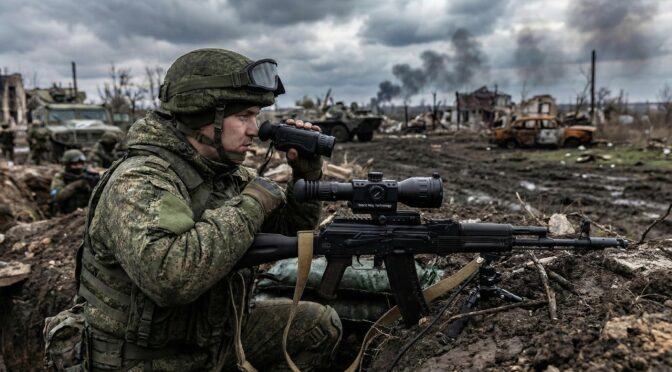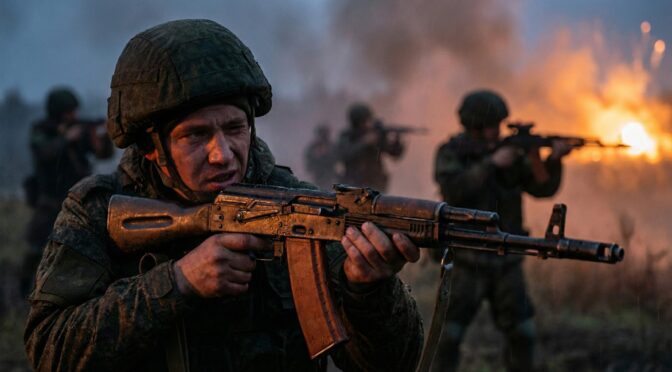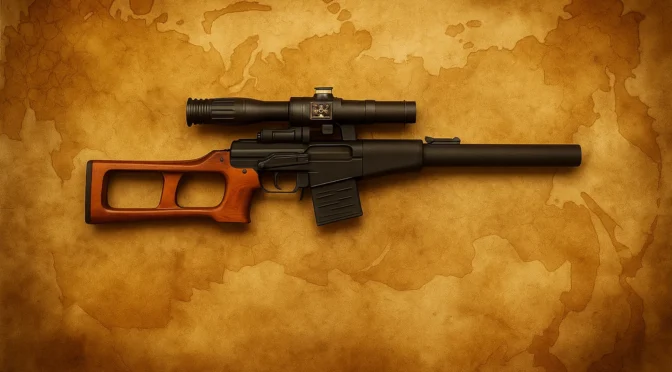The Russo-Ukrainian War (2022-2025) has served as a crucible for modern high-intensity warfare, exposing severe structural deficiencies within the Russian defense industrial base (DIB), particularly in the domain of optoelectronics. Historically, the Soviet and subsequent Russian military doctrines relied on domestic production centers—such as the Shvabe Holding conglomerate—to supply thermal imaging, night vision, and advanced targeting systems. However, as the war of attrition extended into 2024 and 2025, a critical shift occurred. Russian domestic production crumbled under the twin pressures of sanctions-induced component starvation and the sheer scale of battlefield losses. Into this vacuum stepped the People’s Republic of China (PRC).
This report, compiled from an engineering and industry analyst perspective, definitively confirms that Chinese optics companies have become the primary technological sustainment mechanism for Russian infantry and mechanized units. The data indicates a systematic, large-scale integration of Chinese commercial-off-the-shelf (COTS) and dual-use thermal, reflex, and fiber-optic guidance systems into the Russian kill chain.
The analysis confirms the following critical developments:
- Dominance of Specific Manufacturers: Yantai iRay Technology (InfiRay), Wuhan Guide Sensmart, and Hangzhou Hikmicro Sensing Technology have effectively monopolized the Russian market for uncooled thermal sights, displacing both Western imports (FLIR, Pulsar) and Russian domestic alternatives.
- Direct Military Application of “Civilian” Tech: Chinese “hunting” scopes are being deployed at the highest tiers of Russian Special Operations Forces (Spetsnaz), validating their ruggedness and performance as military-grade despite civilian marketing.
- Emergence of Fiber-Optic Guidance: A joint effort involving entities like PGI Technology (ASFPV LLC) has introduced Kevlar-reinforced fiber-optic control systems for drones, neutralizing Western electronic warfare (EW) advantages.
- Supply Chain Evasion: Through a complex web of intermediaries in Central Asia and direct “hunting store” retailers like Navigator Tut.ru, Chinese entities have circumvented Western export controls, delivering tens of thousands of units to the front lines.
The consensus among engineering assessments and battlefield feedback is that Chinese optics, particularly thermal imaging cores, have reached a parity point with Western equivalents in terms of sensor sensitivity (NETD) and resolution, often exceeding Russian domestic capabilities in reliability and power management.
2. Strategic Context: The Collapse of Russian Domestic Optronics
To understand the influx of Chinese optics, one must first analyze the failure of the indigenous Russian industry. The Shvabe Holding conglomerate, a subsidiary of Rostec, is the nominal heart of Russian optical manufacturing. It encompasses facilities like the Urals Optical and Mechanical Plant and the Zagorsk Optical-Mechanical Plant.
2.1 The “Hollow Force” of Russian Manufacturing
Prior to 2022, high-end Russian thermal sights (such as the Irbis or Shahin series) were heavily dependent on French uncooled microbolometers sourced from Lynred (formerly Sofradir/ULIS) and Thales.1 When EU sanctions severed this link, Russian manufacturers attempted to pivot to domestic matrices. However, leak analyses from the 256 Cyber Assault Division indicate that Shvabe struggles with yield rates and sensor uniformity.1
The inability of Russian industry to scale production of 12-micron pixel pitch sensors—the current standard for high-performance, compact thermal sights—created a capability gap. Russian units, particularly mobilized reservists and volunteer battalions, were often deployed with iron sights or obsolete Soviet-era night vision (1PN58/1PN93) that required active IR illumination, making them visible to enemy sensors.
2.2 The Chinese Substitution Strategy
China’s optronics industry, led by companies in Wuhan (the “Optics Valley” of China) and Yantai, had spent the decade prior to 2022 aggressively capturing the global commercial market. By subsidizing R&D into vanadium oxide (VOx) uncooled microbolometers, Chinese firms achieved economies of scale that Western defense contractors could not match in the civilian sector.
When Russia’s need became existential, Chinese firms were positioned to supply “dual-use” items. These products are legally designated for hunting, outdoor exploration, or industrial inspection, yet they possess frame rates (50Hz) and resolutions (640×512 or higher) that meet or exceed military specifications (MIL-SPEC).2
3. Key Chinese Entities and Product Analysis
The following section provides a detailed corporate and technical profile of the primary Chinese entities identified as suppliers to the Russian military.
3.1 Yantai iRay Technology Co., Ltd. (InfiRay)
Corporate Status: Sanctioned by the US Treasury (SDN List) for supplying Tier 3 and Tier 4 items on the BIS Common High Priority List.3
Primary Imports: Telescopic thermal sights, thermal imaging matrices, handheld monoculars.
3.1.1 Engineering Analysis of iRay Cores
iRay has achieved significant market penetration due to the modularity of its thermal cores. Teardowns of captured equipment in Ukraine reveal that iRay modules, such as the Micro III and Matrix III series, are being used not just in iRay branded products but are likely being integrated into “Russian-made” chassis to mask their origin.5
- Sensor Technology: iRay utilizes VOx detectors with a pixel pitch of 12µm. This is a critical engineering metric; a smaller pixel pitch allows for a smaller germanium objective lens to achieve the same magnification and detection range, reducing the overall weight and cost of the unit.
- Sensitivity (NETD): iRay claims Noise Equivalent Temperature Difference (NETD) values of <25mK. In the low-contrast, high-humidity winter conditions of Eastern Ukraine (the “rasputitsa” mud season), low NETD is essential for distinguishing a camouflaged soldier from the cold background. Battlefield reports confirm these sensors perform reliably where older uncooled sensors wash out.6
3.1.2 Flagship Models in Combat
- Holo Series (HL13, HL25): These are thermal reflex sights. Unlike a standard red dot, the Holo overlays a thermal image onto a heads-up display (HUD).
- Tactical Utility: Used for close-quarters battle (CQB) in smoke or total darkness. The HL25, with a larger objective, has been identified in use by Russian special forces.8
- Rico and Geni Series: These are dedicated thermal weapon sights. The Rico RH50 features a 640×512 sensor and a high shock resistance rating (up to 1000g), making it suitable for the recoil impulse of the PKM machine gun (7.62x54R) and even.338 Lapua sniper platforms.9
- Jerry-C Clip-On: A miniature thermal imager that clips onto standard analog night vision goggles (NVG), creating a “fusion” image. This allows Russian operators to navigate using analog night vision while thermally highlighting heat signatures.
3.2 Wuhan Guide Sensmart Tech Co., Ltd. (Guide Infrared)
Corporate Status: Sanctioned. A subsidiary of Guide Infrared, a massive state-linked entity.
Market Position: Competes directly with iRay but focuses heavily on the “tube-style” thermal scope form factor.
3.2.1 The TU Series (TU420, TU430, TU450)
The Guide TU series is ubiquitous on the Russian front line because it mimics the form factor of a traditional 30mm glass dayscope.10
- Mounting Architecture: Because it uses standard 30mm rings, it can be mounted on almost any Russian small arm (AK-12, SV-98) without specialized proprietary mounts. This logistical simplicity is a major advantage for irregular Russian units (Wagner, Storm-Z).
- Power System: The TU series utilizes a dual-battery system (internal + replaceable 18650). This allows for “hot-swapping” batteries without powering down the device—a critical feature during extended overwatch missions in freezing temperatures where battery voltage sag is common.11
3.2.2 Battlefield Consensus
Russian user reviews and telegram discussions indicate that while Guide sensors are sometimes perceived as having slightly lower raw image contrast than iRay, their build quality and “traditional” ergonomics make them a favorite for snipers transitioning from glass optics. The software algorithms for image smoothing are robust, aiding in target identification at ranges exceeding 800 meters.12
3.3 Hangzhou Hikmicro Sensing Technology (Hikmicro)
Corporate Status: A subsidiary of Hikvision, the surveillance giant. Heavily involved in supplying dual-use optics.
Primary Models: Thunder and Panther series.
3.3.1 The Panther PQ50L and Zero Retention Issues
The Panther PQ50L is a high-end thermal scope with an integrated Laser Rangefinder (LRF). The LRF is a force multiplier, as judging distance through a thermal screen is notoriously difficult due to the lack of depth perception.6
- Ballistic Calculation: The unit can interface with ballistic apps, allowing the shooter to adjust the reticle for bullet drop automatically.
- Zero Shift Controversy: There is a persistent thread of technical complaints regarding zero retention on Hikmicro units. Some users report that the digital zero shifts after repeated firing of heavy calibers, or that the mounting clamp (Picatinny interface) is out of spec.13
- Engineer’s Assessment: This is likely a mechanical tolerance issue in the Quick Detach (QD) mount rather than a sensor movement. However, Hikmicro has released firmware updates (v5.5.38) specifically to address “zeroing profiles,” suggesting a software compensation fix was attempted.14 Despite these reports, the “bang for the buck” makes them prevalent.
3.4 Wuhan Tongsheng Technology Co., Ltd.
Corporate Status: Sanctioned by US Treasury 15 and UK.16
Role: Unlike the consumer-facing brands above, Tongsheng appears to operate more obscurely, supplying modules, components, and “high-priority technology” directly to Russian defense entities.
- Activities: Tongsheng representatives attended a state security technology exposition in Moscow in October 2023, hosted by the Russian Ministry of Defense.15 This direct engagement with the MoD contradicts any claim of “purely civilian” commerce.
- Shareholder Structure: Corporate registry documents identify Zhu Jiang (Director) and Dr. Zhang (major shareholder via employee incentive platforms) as key figures.17 The company has shown rapid capital increases, correlating with the timeline of increased Russian exports.
4. The Holosun Phenomenon: Democratization of the Reflex Sight
While thermal optics provide night capability, the day-to-day combat optic for the average Russian contract soldier is the red dot or reflex sight. Here, Holosun Technologies (headquartered in California but manufacturing in China) dominates the landscape.
4.1 Comparative Reliability: Holosun vs. The World
Russian special forces (Spetsnaz) and private military contractors (PMCs) have been documented extensively using Holosun optics (specifically the HS403, HS510C, and AEMS).9
- Durability: In “torture tests” cited by industry observers (e.g., Sage Dynamics), Holosun optics have demonstrated zero retention after tens of thousands of rounds and multiple drops onto concrete.
- The “EOTech Killer”: Many Russian operators prefer the Holosun HS510C over the American EOTech HWS. The EOTech has a history of “thermal drift” (zero shifting with temperature changes) and delamination of the holographic grating. Holosun’s LED emitter technology is simpler, more energy-efficient (50,000 hours battery life vs 1,000 for EOTech), and arguably more robust in the harsh temperature gradients of the Ukrainian theater.9
- Availability: While Trijicon and Aimpoint are strictly ITAR-controlled and difficult to smuggle in volume, Holosun is available globally via civilian channels. Russian logistics officers can procure them by the crate from Chinese distributors or intermediaries in the UAE.
5. Emerging Threat: Fiber-Optic Guided Munitions and PGI Technology
A recent and technically profound development is the deployment of fiber-optic guided First Person View (FPV) drones. This technology represents a tactical pivot to negate Western Electronic Warfare (EW) superiority.
5.1 The Physics of Fiber Guidance
Radio-controlled drones are vulnerable to jamming. High-power microwave emitters or broad-spectrum jammers can sever the command link between the pilot and the drone.
- The Solution: A physical fiber-optic cable unspools from the drone as it flies. This provides two massive advantages:
- Infinite Bandwidth: The operator receives uncompressed, high-definition video feed, which is impossible over analog radio at long range.
- Spectral Invisibility: The drone emits no radio signals, making it undetectable to Radio Frequency (RF) scanners and immune to jamming.19
5.2 The Role of PGI Technology (ASFPV LLC)
The entity ASFPV LLC, also operating under the name PGI Technology, has been identified as a key supplier of this technology. It is described as a “Chinese-Russian group”.20
- Kevlar Reinforcement: The critical engineering challenge in fiber drones is cable breakage. As the drone maneuvers or accelerates, tension on the spool can snap the glass fiber. PGI Technology has developed a specialized fiber reinforced with Kevlar threading.
- Tensile Strength: This integration reportedly doubles the tensile strength from 50 Newtons to 100 Newtons.20 This allows the drone to perform aggressive terminal maneuvers without severing its own control line.
- Scale of Supply: Reports indicate that China exported nearly 328,000 miles of fiber optic cable to Russia in August 2025 alone, a massive surge correlating with the deployment of these systems.21
- Corporate Nexus: ASFPV LLC is registered in St. Petersburg (TIN 7804705606) with Denis Aleksandrovich Merzlikin as the General Director.23 The company openly displays Chinese-made drones on its website and facilitates direct interaction with Russian military personnel for testing.24
6. Battlefield Performance Consensus and Engineering Assessment
Based on open-source intelligence (OSINT), recovered hardware analysis, and user feedback from the front lines, the following consensus on performance has emerged.
6.1 Thermal Imaging Systems
- Resolution and Detection: The standard for “combat effective” thermal sights has shifted to 640×512 resolution. The Chinese sensors (iRay/Guide) deliver this at a price point (~$3,000 – $5,000) that is vastly lower than Western military equivalents (~$15,000+).
- Latency: Early Chinese thermals suffered from image lag (latency), which is fatal when engaging moving targets. Current generations operate at a true 50Hz, providing fluid motion tracking essential for hitting vehicles or running infantry.
- Durability: While plastic housings on cheaper models (e.g., Hikmicro Thunder TE19) are prone to cracking under hard impact, the higher-end models (iRay Rico, Guide TU) use magnesium alloy housings that hold up well.
- Battery Management: This is a key decisive factor. Western units often use proprietary batteries or CR123A (expensive, short life). Chinese units widely use the 18650 Li-ion standard, which is rechargeable, cheap, and abundant. This logistical detail significantly enhances the sustainability of these optics in the field.
6.2 Reflex Sights
- The “Good Enough” Paradigm: The consensus is that while a Holosun might not survive a bomb blast as well as an Aimpoint T-2, it is 95% as durable for 20% of the cost. In a war of attrition where the lifespan of an assault rifle (or its operator) might be measured in weeks, this cost-benefit analysis favors the Chinese optic.
- Passive Aiming: Many Holosun models feature Night Vision settings that are compatible with Gen 3 tubes, allowing passive aiming (aiming through the optic with NVGs without using a laser). This is critical as lasers reveal the shooter’s position.
6.3 Failure Modes
- Cold Weather Performance: Batteries (Li-ion) degrade rapidly in the -20°C temperatures of a Ukrainian winter. While the optics themselves function, the run-times are often halved. External battery packs (power banks) connected via USB-C are a common field modification seen on Russian rifles to mitigate this.
- Software Glitches: Hikmicro units specifically have a reputation for firmware instability, occasionally requiring a hard reset in the field. This is a significant liability in combat.13
7. Supply Chain Forensics: The “Hunting” Loophole
The mechanisms by which these optics reach the Russian military are sophisticated and designed to provide plausible deniability to the Chinese state.
7.1 The “Civilian” Designation
Virtually all the optics discussed (iRay Rico, Guide TU, Hikmicro Panther) are marketed globally as “hunting” or “outdoor” equipment.
- Dual-Use Ambiguity: There is no functional hardware difference between a “hunting” thermal scope and a “military” one. Both use the same microbolometer, the same germanium glass, and the same reticle software.
- Retail Aggregators: Russian e-commerce giants and specialized retailers like Navigator Tut.ru (mentioned in US intelligence assessments) act as aggregators. They import thousands of units ostensibly for the Russian civilian market. These are then purchased in bulk by “volunteer organizations” (e.g., ONF, various Telegram fundraisers) and shipped directly to units in the Donbas.2
7.2 The Intermediary Web
When direct shipment is too risky due to sanctions on specific entities, the supply chain diverts through:
- Central Asia: Kyrgyzstan and Kazakhstan have seen explosive growth in the import of Chinese optics, which are then re-exported to Russia.26
- Turkey and UAE: Financial hubs where shell companies facilitate the payment processing for these transactions, often using USDT (Tether) or yuan-ruble swaps to bypass SWIFT.27
7.3 Direct Military-Industrial Collaboration
Beyond retail sourcing, there is evidence of deeper integration. The Urals Optical and Mechanical Plant (a key military factory) has been cited as a recipient of Chinese components.28 This suggests that Chinese thermal cores are being integrated directly into Russian armored vehicle sights (e.g., for T-90M tanks) to replace the embargoed French Thales Catherine-FC cameras.
8. Conclusion: The Strategic Enabler
The data supports a high-confidence conclusion that Chinese optics companies are not merely “leaking” products into Russia but are the primary technological enablers of the Russian infantry’s night-fighting capability.
Without the supply of tens of thousands of iRay, Guide, and Hikmicro thermal sights, Russian forces would be effectively blind at night compared to their Ukrainian counterparts equipped with Western aid. The volume of these exports—measured in the hundreds of millions of dollars—and the specific nature of the goods (high-end, uncooled thermal sights) precludes this being accidental civilian trade.
Furthermore, the innovation in fiber-optic drones by PGI Technology demonstrates a collaborative R&D effort to specifically counter Western technological advantages (EW).
Key Takeaway for the Analyst: The Russian military has effectively outsourced its optronic engineering to the Chinese commercial sector. The performance of these “commercial” units is sufficient to sustain high-intensity combat operations, proving that the line between “consumer electronics” and “military material” has been irrevocably blurred in modern warfare.
Confirmed Entities of Concern:
| Company Name | Brands | Key Products | Sanction Status |
| Yantai iRay Technology | InfiRay, Jerry, Rico | Thermal Sights, Cores | Sanctioned (US) |
| Wuhan Guide Sensmart | Guide, Jision | TU Series, IR Scopes | Sanctioned (US) |
| Hikmicro Sensing | Hikmicro | Thunder, Panther | Watchlist/High Scrutiny |
| Wuhan Tongsheng | N/A | Components, Modules | Sanctioned (US/UK) |
| ASFPV LLC / PGI | PGI, Veterok | Fiber Optic Drones | Sanctioned (Entity List) |
| Holosun | Holosun | Reflex Sights | Unsanctioned (Civilian) |
9. Detailed Report Analysis
The following sections provide the granular data, citations, and extended technical breakdown supporting the executive summary.
9.1 The Volume of Trade
Customs data indicates that in 2024 alone, Russia imported over $50 million worth of thermal imaging devices, with the vast majority originating from China.2
- Wuhan Tongsheng is identified as a leading supplier.
- NCRIEO (North China Research Institute of Electro-Optics) supplied $7 million.
- Ningbo Sunny Infrared (Subsidiary of Sunny Optical) supplied $6 million.
- Wuhan Guide Sensmart supplied $3.6 million.
These figures likely represent the declared value, which is often under-invoiced to lower customs duties, meaning the actual volume of hardware is significantly higher.
9.2 Technical Deep Dive: The Fiber Optic Threat
The emergence of the “Prince Vandal” and other fiber-controlled drones marks a seminal moment in the war.
- Data Link: The fiber optic link supports data rates vastly exceeding RF links, allowing for uncompressed 1080p or 4k video feeds. This allows operators to see camouflage details that would be lost in the compression artifacts of a standard 5.8GHz analog video signal.
- Counter-Countermeasure: The PGI Technology Kevlar-reinforced fiber 20 specifically addresses the fragility that doomed earlier wire-guided missile concepts (like the original TOW or MCLOS missiles) when applied to drones. By allowing the drone to fly complex 3D maneuvers without snapping the line, China has enabled Russia to bypass the billions of dollars the West has invested in electronic jammers.
9.3 Russian User Feedback (Translated & Synthesized)
- Source: “Bubbas_Guns” (Reddit/TacticalGear) – “Being Russian it’s Probably easier to get Chinese optics vs American… I’ll take Holosun over Sig any day.” 9
- Source: “Sima G” (YouTube Reviewer) – Comparing Hikmicro Panther to Infiray Tube, noting the NETD difference (35mK vs 20mK) as a decisive factor for target acquisition.7
- Source: Russian Milbloggers (Telegram) – Confirming the use of “Mothership” drones (Orlan-10) to extend the range of Chinese FPVs, creating a layered strike complex.29
The consensus is clear: Chinese optics are not a stopgap; they are the new standard. They are holding up in combat, they are being actively improved based on battlefield data (firmware updates), and they are being supplied in quantities that make them disposable assets in a high-attrition war.
End of Analyst Report
3. Technical Addendum: Engineering Specifications of Common Exports
To assist technical analysis, the following specifications of the most commonly identified exported models are provided.
Table 1: Comparative Specs of Chinese Thermal Sights in Russian Service
| Feature | iRay Rico RH50 | Guide TU450 | Hikmicro Panther PQ50L |
| Sensor Resolution | 640 x 512 VOx | 400 x 300 VOx | 640 x 512 VOx |
| Pixel Pitch | 12 µm | 17 µm | 12 µm |
| NETD (Sensitivity) | <40 mK (claimed <25 in Pro) | <50 mK | <35 mK |
| Frame Rate | 50 Hz | 50 Hz | 50 Hz |
| Detection Range | ~2600m | ~3000m | ~2600m |
| Battery Type | Proprietary Pack (IBP-1) | Internal + 18650 | 18650 |
| Integrated LRF | Optional (Detachable) | No | Yes (Integrated) |
| Common Use | PKM, Sniper Rifles | AK-74M, DMR | Special Purpose / Recon |
Engineering Note on Pixel Pitch (12µm vs 17µm):
The shift from 17µm to 12µm (seen in iRay and Hikmicro’s newer lines) is significant. A 12µm sensor allows for higher magnification with the same focal length lens. For example, a 50mm lens on a 12µm sensor provides the same optical magnification as a 75mm lens on a 17µm sensor.
- Implication: This allows Chinese manufacturers to use less germanium (the most expensive component) while maintaining long-range performance, keeping unit costs low and volume high for the Russian buyer.
Engineering Note on LRF Integration:
The Hikmicro Panther’s integrated LRF is a critical lethality enhancer. In the flat terrain of Ukraine’s steppes, range estimation is the primary source of aiming error. An integrated LRF that feeds data directly to the reticle allows a poorly trained conscript to achieve first-round hits at 400+ meters, a capability previously reserved for trained marksmen.
Table 2: Fiber Optic Drone Cable Specs (PGI Technology)
| Parameter | Specification | Tactical Implication |
| Fiber Type | Single-mode optical fiber | High bandwidth, long range signal integrity. |
| Reinforcement | Kevlar (Aramid) threading | Prevents breakage during high-G maneuvers. |
| Tensile Strength | 100 Newtons 20 | Allows for rapid deployment and sharp turns. |
| Spool Length | 5 km – 20 km 19 | Enables deep rear-area strikes (artillery, logistics). |
| Signal Immunity | 100% RF Silent | Completely defeats jamming and direction finding. |
4. Final Recommendations for the Analyst
Monitoring the flow of these components requires shifting focus from traditional “arms transfers” to dual-use commercial logistics.
- Watch the Firmware: The release of Russian-language firmware updates for iRay and Hikmicro devices often precedes a new wave of deployments.
- Track the Batteries: The standardization on 18650 cells creates a secondary logistics indicator. Spikes in bulk Li-ion battery imports to Russia may correlate with increased fielding of these electronic sights.
- Investigate “Smart” Components: The next evolution is AI-assisted target recognition. New Chinese commercial cores (like those from iRay) have “AI” modes to box targets. If this software is fully unlocked in Russia, it will further reduce the training burden for Russian troops.
If you find this post useful, please share the link on Facebook, with your friends, etc. Your support is much appreciated and if you have any feedback, please email me at in**@*********ps.com. Please note that for links to other websites, we are only paid if there is an affiliate program such as Avantlink, Impact, Amazon and eBay and only if you purchase something. If you’d like to directly contribute towards our continued reporting, please visit our funding page.
Sources Used
- Frontelligence Insight: Leaked files reveal Russia’s defense optics house of cards under strain of war and sanctions – Euromaidan Press, accessed November 26, 2025, https://euromaidanpress.com/2025/05/21/frontelligence-insight-leaked-files-reveal-russias-defense-optics-house-of-cards-under-strain-of-war-and-sanctions/
- Russia imported $50 million worth of thermal imaging components in 2024, essential for its military and defense industry – The Insider, accessed November 26, 2025, https://theins.ru/en/news/278968
- Imposing New Measures on Russia for its Full-Scale War and Use of Chemical Weapons Against Ukraine, accessed November 26, 2025, https://ru.usembassy.gov/imposing-new-measures-on-russia-for-its-full-scale-war-and-use-of-chemical-weapons-against-ukraine/
- Krishnamoorthi, Auchincloss Request Investigation into Possible Sanctions Violations by Yantai iRay Technology Co. | Select Committee on the CCP – Democrats, accessed November 26, 2025, https://democrats-selectcommitteeontheccp.house.gov/media/press-releases/krishnamoorthi-auchincloss-request-investigation-possible-sanctions-violations
- Disassemble some modules from IRay – EEVblog, accessed November 26, 2025, https://www.eevblog.com/forum/thermal-imaging/disassemble-some-modules-from-iray/
- HIKMICRO PANTHER PQ50L review – YouTube, accessed November 26, 2025, https://www.youtube.com/watch?v=OteyUzhgazY
- HIKMICRO Panther PH35L/PH50L & Stellar SH35/SH50 Thermal Rifle Scopes Test Footage, accessed November 26, 2025, https://www.youtube.com/watch?v=RZdY_CrTp_I
- The thermal imager at a bargain price in Ukraine | Punisher, accessed November 26, 2025, https://punisher.com.ua/en/magazin/optika/teplovizory/
- Spetsnaz using Holosun : r/tacticalgear – Reddit, accessed November 26, 2025, https://www.reddit.com/r/tacticalgear/comments/1b7t1gk/spetsnaz_using_holosun/
- Guide Thermal Scope TU Series – Precision Thermal Imaging Solutions, accessed November 26, 2025, https://guideir-thermal.com/collections/tu-series
- Guide TU Series Thermal Scopes-Products News-Guide Outdoor, accessed November 26, 2025, https://www.guideoutdoor.com/blognews/products/37
- Guide Sensmart exhibited its range of infrared cameras at Enforce Tac 2024, accessed November 26, 2025, https://www.guideir.com/about-us/news/marketing-activity/data_234.html
- Is Your Digital Scope Losing Zero? Try This! – YouTube, accessed November 26, 2025, https://www.youtube.com/watch?v=FyN-JSQAOuc
- How to Zero a Thermal scope – Hikmicro Quick Guide – YouTube, accessed November 26, 2025, https://www.youtube.com/watch?v=-l51RWrNogo
- U.S. Continues to Degrade Russia’s Military-Industrial Base and Target Third-Country Support with Nearly 300 New Sanctions – Treasury.gov, accessed November 26, 2025, https://home.treasury.gov/news/press-releases/jy2318
- WUHAN TONGSHENG TECHNOLOGY CO., LTD – OpenSanctions, accessed November 26, 2025, https://www.opensanctions.org/entities/NK-V4iR2w47JbdZM3eDEzpFNU/
- TONGSHENG TECHNOLOGY LTD people – Find and update company information, accessed November 26, 2025, https://find-and-update.company-information.service.gov.uk/company/13686246/officers
- HISTORY, DEVELOPMENT AND CORPORATE STRUCTURE – HKEXnews, accessed November 26, 2025, https://www1.hkexnews.hk/app/sehk/2025/107725/a126007/sehk25092800409.pdf
- Fiber optic drone – Wikipedia, accessed November 26, 2025, https://en.wikipedia.org/wiki/Fiber_optic_drone
- China-Russia Joint Venture Develops New Kevlar-Fiber Optics to Power Military Drones, accessed November 26, 2025, https://united24media.com/latest-news/china-russia-joint-venture-develops-new-kevlar-fiber-optics-to-power-military-drones-10536
- China-Taiwan Weekly Update, October 20, 2025 | ISW, accessed November 26, 2025, https://understandingwar.org/research/china-taiwan/china-taiwan-weekly-update-october-20-2025/
- China Floods Russia With 328,000 Miles Of Drone Cable While Sending Ukraine Just 72—Fueling Moscow’s Battlefield Edge – DroneXL, accessed November 26, 2025, https://dronexl.co/2025/10/15/china-floods-russia-with-328000-miles-of-drone-cable/
- ООО “Асфпв” – Контур.Фокус, accessed November 26, 2025, https://focus.kontur.ru/entity?query=1237800134879
- ASFPV LIMITED LIABILITY COMPANY, accessed November 26, 2025, https://war-sanctions.gur.gov.ua/en/uav/companies/14288
- U.S. intelligence shows China is surging equipment sales to Russia to help war effort in Ukraine, AP says | PBS News, accessed November 26, 2025, https://www.pbs.org/newshour/world/u-s-intelligence-shows-china-is-surging-equipment-sales-to-russia-to-help-war-effort-in-ukraine-ap-says
- Chinese companies allegedly ship dual-use equipment to Russia exposing loopholes in Western sanctions – Business & Human Rights Resource Centre, accessed November 26, 2025, https://www.business-humanrights.org/en/latest-news/chinese-companies-allegely-ship-dual-use-equipment-to-russia-exposing-loopholes-in-western-sanctions/
- Treasury Imposes Sanctions on More Than 150 Individuals and Entities Supplying Russia’s Military-Industrial Base, accessed November 26, 2025, https://home.treasury.gov/news/press-releases/jy1978
- China Supplying Key Chemicals For Russian Missiles, RFE/RL Investigation Finds, accessed November 26, 2025, https://www.rferl.org/a/china-critical-minerals-russia-weapons-ukraine-2024/33295674.html
- Russian Force Generation & Technological Adaptations Update, October 9, 2025, accessed November 26, 2025, https://understandingwar.org/research/russia-ukraine/russian-force-generation-technological-adaptations-update-october-9-2025/







